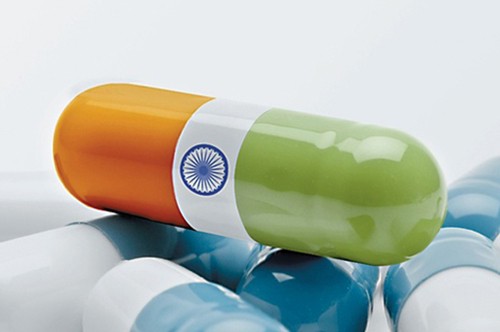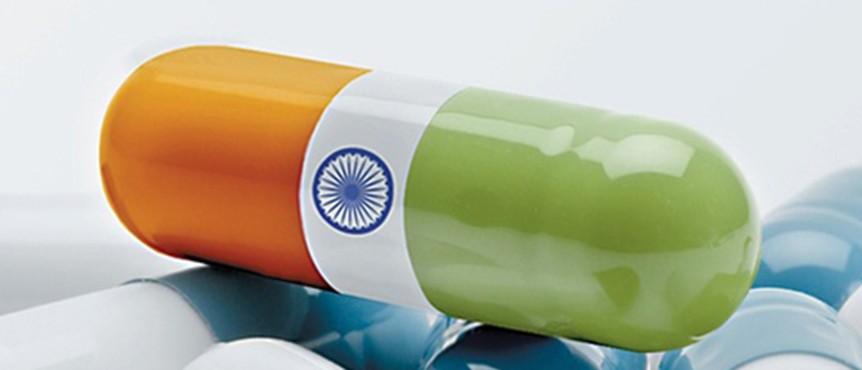The largest supplier of generic drugs globally, India continues to fortify its reputation as a hub for the production of affordable quality medicines.


From 2005 to 2016, the Indian pharmaceutical market multiplied by a factor of about six, from US$6 billion to US$36.7 billion, with some estimates projecting further expansion at a CAGR of almost 16% to US$55 billion by 2020. A large percentage of pharmaceutical revenue is generated through exports, with India’s exported pharmaceutical products reaching US$16.89 billion in value in FY16. However, whilst the Indian pharmaceutical sector accounts for about 10% of pharmaceutical volume globally, ranking third, it only accounts for about 2.4% in value, coming in at 14th.
India’s competitive edge on the international stage comes primarily from the low cost of production, making the country an ideal manufacturing base for multinationals as well as smaller domestic companies. All the top multinationals, such as Johnson & Johnson, GlaxoSmithKline, Pfizer and Novartis have manufacturing facilities in India, alongside international Indian leaders such as Sun Pharma, Lupin, Dr. Reddy’s, CIPLA, Aurobindo and Glenmark. “India has a competitive edge because of cost efficiency, portfolio diversification, economic drivers and policy support,” noted Daara Patel, secretary general at the Indian Drug Manufacturers’ Association (IDMA), which has over 1000 members across India, comprising large, medium and small national manufacturers. “India’s cost of production is approximately 60% lower than that of the United States and almost half that of Europe…In terms of portfolio diversification, India is the origin of 60,000 generic brands across 60 therapeutic categories and manufactures more than 500 different APIs. 35% of all drug master filings from India in 2015 were registered in the United States.”
As India seeks to increase its prominence globally, the main barrier faced by companies is the requirements of highly regulated markets. The U.S. Food and Drug Administration (FDA) continues to set the gold standard globally but the European market has its own requirements. An increase in 483s from the United States to Indian manufacturers has been widely discussed as a reflection of a crackdown on facilities manufacturing poor quality products.
One of the main areas of focus will be documentation, for which associations such as the IDMA are rolling out training programs and support. “Data integrity issues arise when regulators are not convinced of the data based on which the products are launched in the market,” explained Rashida Najmi, global head of regulatory, pharmacovigilance(PV) and patents at Piramal Healthcare. “In 2015, 74% of the total warning letters issued by US FDA were linked to DI and the number increased to 79% in 2016.”
Nevertheless, India still houses the highest number of FDA-approved facilities outside of the United States. “Inspections are routine as part of regulatory exercise,” commented Patel. “The 483s from the United States go to every company and data shows that even a number of U.S. companies receive such warnings. There is nothing new in this. As the quantum of business increases, so does the chance of receiving these letters. Because of ever-increasing media activities and sensitive financial bourses these things are getting blown out of proportion; the quality of Indian medicines is well accepted all over the world.”
As the North American pharmaceutical market is the largest in terms of value, India’s companies will remain focused on attaining and maintaining FDA approval.
Whilst India has strong capabilities across generic products, its reliance on API imports, particularly from China, could become more challenging going forward. Because China is benefitting more greatly from research and government support, the lead will only increase unless India’s government steps in. The government is aware of a need to improve national API capabilities, even branding 2015 the “Year of the API”, but so far not much improvement has been seen to the frustration of the industry. China is viewed by many as an unreliable supplier and, if Chinese companies were to turn their attention to regulated markets, India would be better positioned if a robust API network were in place.
Many API companies are looking to vertically integrate to mitigate impacts of potential supply shortages or dips in demand. This would also help to capture more value within the country – a big challenge in India’s pharmaceutical industry, where international companies often add a great deal of value after the products are exported.
Going forward, the government’s role in the development of India’s pharmaceutical industry will be integral. The measures to be taken under its ‘Pharma Vision 2020’, aimed at making India a global leader in end-to-end drug manufacture, will go some way to securing greater market share and capturing more value within the country.

From 2005 to 2016, the Indian pharmaceutical market multiplied by a factor of about six, from US$6 billion to US$36.7 billion, with some estimates projecting further expansion at a CAGR of almost 16% to US$55 billion by 2020. A large percentage of pharmaceutical revenue is generated through exports, with India’s exported pharmaceutical products reaching US$16.89 billion in value in FY16. However, whilst the Indian pharmaceutical sector accounts for about 10% of pharmaceutical volume globally, ranking third, it only accounts for about 2.4% in value, coming in at 14th.
India’s competitive edge on the international stage comes primarily from the low cost of production, making the country an ideal manufacturing base for multinationals as well as smaller domestic companies. All the top multinationals, such as Johnson & Johnson, GlaxoSmithKline, Pfizer and Novartis have manufacturing facilities in India, alongside international Indian leaders such as Sun Pharma, Lupin, Dr. Reddy’s, CIPLA, Aurobindo and Glenmark. “India has a competitive edge because of cost efficiency, portfolio diversification, economic drivers and policy support,” noted Daara Patel, secretary general at the Indian Drug Manufacturers’ Association (IDMA), which has over 1000 members across India, comprising large, medium and small national manufacturers. “India’s cost of production is approximately 60% lower than that of the United States and almost half that of Europe…In terms of portfolio diversification, India is the origin of 60,000 generic brands across 60 therapeutic categories and manufactures more than 500 different APIs. 35% of all drug master filings from India in 2015 were registered in the United States.”
As India seeks to increase its prominence globally, the main barrier faced by companies is the requirements of highly regulated markets. The U.S. Food and Drug Administration (FDA) continues to set the gold standard globally but the European market has its own requirements. An increase in 483s from the United States to Indian manufacturers has been widely discussed as a reflection of a crackdown on facilities manufacturing poor quality products.
One of the main areas of focus will be documentation, for which associations such as the IDMA are rolling out training programs and support. “Data integrity issues arise when regulators are not convinced of the data based on which the products are launched in the market,” explained Rashida Najmi, global head of regulatory, pharmacovigilance(PV) and patents at Piramal Healthcare. “In 2015, 74% of the total warning letters issued by US FDA were linked to DI and the number increased to 79% in 2016.”
Nevertheless, India still houses the highest number of FDA-approved facilities outside of the United States. “Inspections are routine as part of regulatory exercise,” commented Patel. “The 483s from the United States go to every company and data shows that even a number of U.S. companies receive such warnings. There is nothing new in this. As the quantum of business increases, so does the chance of receiving these letters. Because of ever-increasing media activities and sensitive financial bourses these things are getting blown out of proportion; the quality of Indian medicines is well accepted all over the world.”
As the North American pharmaceutical market is the largest in terms of value, India’s companies will remain focused on attaining and maintaining FDA approval.
Whilst India has strong capabilities across generic products, its reliance on API imports, particularly from China, could become more challenging going forward. Because China is benefitting more greatly from research and government support, the lead will only increase unless India’s government steps in. The government is aware of a need to improve national API capabilities, even branding 2015 the “Year of the API”, but so far not much improvement has been seen to the frustration of the industry. China is viewed by many as an unreliable supplier and, if Chinese companies were to turn their attention to regulated markets, India would be better positioned if a robust API network were in place.
Many API companies are looking to vertically integrate to mitigate impacts of potential supply shortages or dips in demand. This would also help to capture more value within the country – a big challenge in India’s pharmaceutical industry, where international companies often add a great deal of value after the products are exported.
Going forward, the government’s role in the development of India’s pharmaceutical industry will be integral. The measures to be taken under its ‘Pharma Vision 2020’, aimed at making India a global leader in end-to-end drug manufacture, will go some way to securing greater market share and capturing more value within the country.